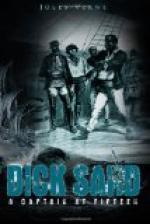For an instant Dick Sand had thought of bringing the “Pilgrim” back to New Zealand. The passage would be shorter, and he would certainly have done it if the wind, which, till then, had been contrary, had not become favorable. Better worth while then to steer for America.
In fact, the wind had changed almost to the contrary direction, and now it blew from the northwest with a tendency to freshen. It was then necessary to profit by it and make all the headway possible.
So Dick Sand prepared to put the “Pilgrim” under full sail.
In a schooner brig-rigged, the foremast carries four square sails; the foresail, on the lower mast; above, the top-sail, on the topmast; then, on the top-gallant mast, a top-sail and a royal.
The mainmast, on the contrary, has fewer sails. It only carries a brigantine below, and a fore-staffsail above. Between these two masts, on the stays which support them at the prow, a triple row of triangular sails may be set.
Finally, at the prow, on the bowsprit, and its extreme end, were hauled the three jibs.
The jibs, the brigantine, the fore-staff, and the stay-sails are easily managed. They can be hoisted from the deck without the necessity of climbing the masts, because they are not fastened on the yards by means of rope-bands, which must be previously loosened.
On the contrary, the working of the foremast sails demands much greater proficiency in seamanship. In fact, when it is necessary to set them, the sailors must climb by the rigging—it may be in the foretop, it may be on the spars of the top-gallant mast, it may be to the top of the said mast—and that, as well in letting them fly as in drawing them in to diminish their surface in reefing them. Thence the necessity of running out on foot-ropes—movable ropes stretched below the yards—of working with one hand while holding on by the other—perilous work for any one who is not used to it. The oscillation from the rolling and pitching of the ship, very much increased by the length of the lever, the flapping of the sails under a stiff breeze, have often sent a man overboard. It was then a truly dangerous operation for Tom and his companions.
Very fortunately, the wind was moderate. The sea had not yet had time to become rough. The rolling and pitching kept within bounds.
When Dick Sand, at Captain Hull’s signal, had steered toward the scene of the catastrophe, the “Pilgrim” only carried her jibs, her brigantine, her foresail, and her top-sail. To get the ship under way as quickly as possible, the novice had only to make use of, that is, to counter-brace, the foresail. The blacks had easily helped him in that maneuver.
The question now was to get under full sail, and, to complete the sails, to hoist the top-sails, the royal, the fore-staff, and the stay-sails.
“My friends,” said the novice to the five blacks, “do as I tell you, and all will go right.”




